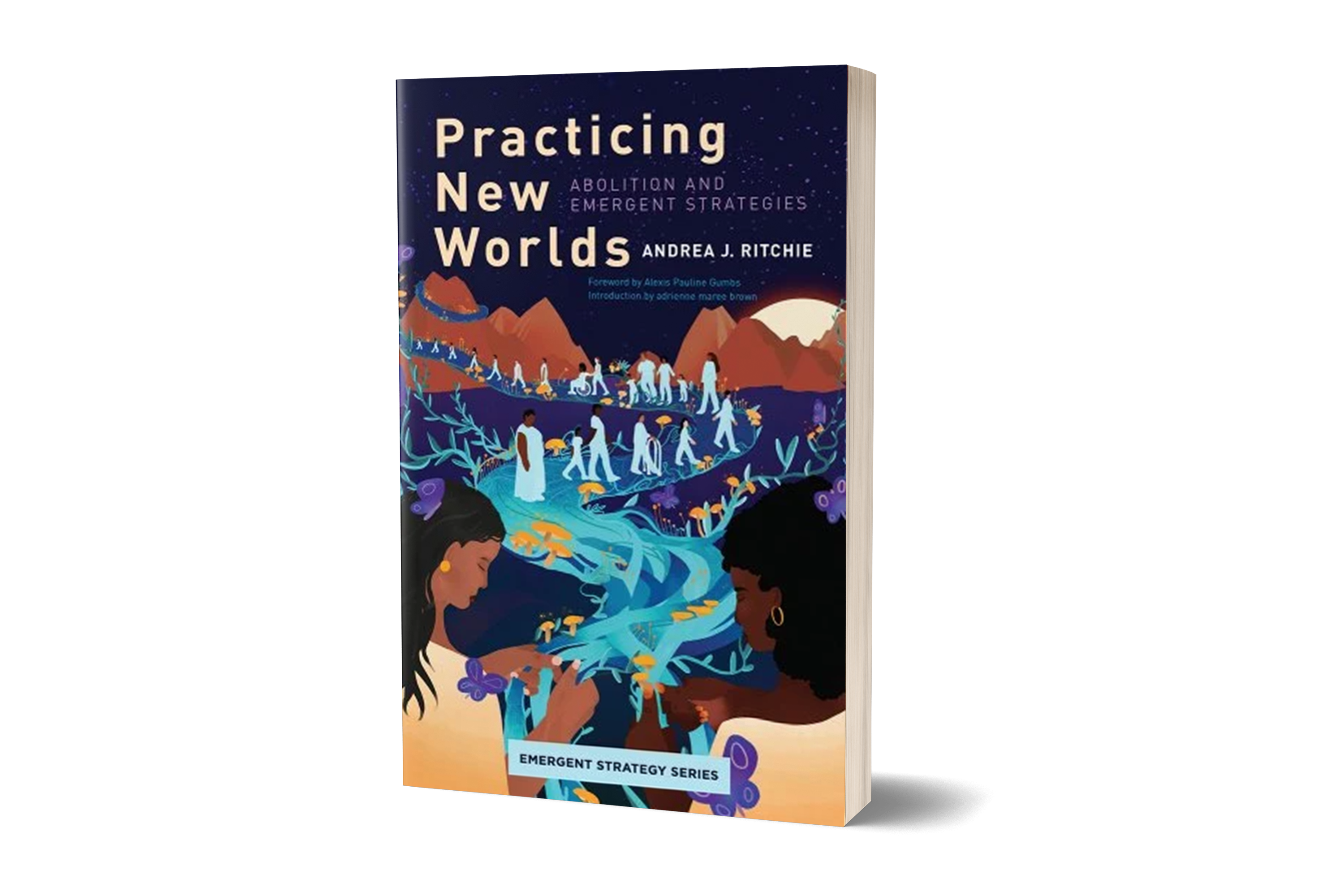Abolitionist organizer, advocate, and author Andrea J. Ritchie hadn’t planned to write a book about emergent strategies for social transformation. After all, as she admits in Practicing New Worlds: Abolition and Emergent Strategies, Ritchie is “an unlikely emergent strategist” (p. 1) who was raised to practice the organized Left’s traditional power-building strategies. But after organizing for policy change and fighting the violence of policing and criminalization as a lawyer, she realized more was needed to fight the Right and build safer, more just futures.
Ritchie wrote Practicing New Worlds after seeing principles of emergence reflected at scale in 2020’s racial justice uprisings, which brought wider attention to abolitionist ideas and demands developed over decades. She observed how local organizers adapted those demands iteratively within shifting conditions and built relationships and networks while learning from one another. As new possibilities for abolitionist struggle developed—despite fierce backlash—Ritchie felt that they warranted a deeper exploration of the principles and strategies behind effective abolitionist organizing.
If experimenting with emergent strategies involves taking risks, Ritchie argues that it’s also essential to surviving and resisting the Right’s rise under racial capitalism. Practicing New Worlds weaves together Black feminist, Indigenous, and queer and trans of color organizing lineages; insights from today’s abolitionists; and imaginative practices like fiction to illustrate how emergent strategies are already “at work in movements and organizations around the globe… shaping how we are building futures without violence” (p. 93). In the process, the book highlights how organizers are creating systems change while dreaming and building the worlds we long for into being.

Ritchie discussed the book’s insights with PRA in an email interview in late December 2023:
PRA: This issue of The Public Eye presents an excerpt from Practicing New Worlds: Abolition and Emergent Strategies (AK Press, 2023) about why emergent strategies matter in a time of rising authoritarianism and fascism. In it, you observe that the Far Right increasingly deploys emergent strategies to spread ideas, recruit members, expand its networks, and build “the dictatorship they seek to impose on broader society.” Could you expand on this? What has your study of emergent strategies contributed to your understanding of the resurgent Right? What are the implications of this understanding for organizing to fight right-wing movements?
Andrea J. Ritchie: Much of our focus with respect to the rise of the Right, authoritarianism, and fascism has been on the seizure of courts, elected office (including by right-wing sheriffs, as PRA has extensively documented[1]), and legislatures. To be sure, we need to fight in those spaces, but we haven’t focused as much as we need to on what made this possible: long-term, decentralized, adaptive organizing by the Right focused on relationships, communities, and networks. What’s happening in the courts and halls of government is just the tip of the iceberg. What we don’t see as clearly, and are now crashing into, is the much larger, hidden bottom of that iceberg: the deep relationships, information systems, and decentralized networks the Right has built over decades through organizing. These are critical sites of struggle because they shape what happens at the level of institutions and systems of power.
Though I’m not an expert on fighting fascism and the resurgent Right, I have learned from so many people about how the Right has organized itself to this moment, and I look to them for guidance and analysis—groups like PRA, and organizers like Kelly Hayes, Shane Burley, Ejeris Dixon, Imara Jones, Ash-Lee Henderson, Suzanne Pharr, Trishala Deb, and Kay Whitlock, among others. What they have taught me, and what abolitionist organizers and people looking to emergent strategies know, is that we need to show up at the level of relationships—because that is what the Right is and has been doing to build power. We are in a battle to push contesting visions of the future through the portal of the present, and our relationships, communities, and networks are the battlefield.
The importance of such critical connections is clear in resistance to Israel’s genocidal violence against Palestinians in Gaza and the West Bank, which is being enacted by the right-wing Likud party with the U.S., European, Australian, and Indian governments’ support. Yes, people are fighting for federal and local ceasefire resolutions, and for legislative and executive action to stop the billions the U.S. has been sending unconditionally to Israel’s military. Those are critical fights. But equally critical are the conversations people are having with family members, friends, and comrades, in their synagogues, churches, and faith communities, that are rooted in relationships and shared values. Small groups are practicing and inviting others into resistance to genocide by becoming affinity groups that participate in larger actions; fasting together; disrupting business as usual; answering calls for general strikes and boycott, divest, and sanctions; mounting and supporting mutual aid and solidarity projects with Palestinians in Gaza and beyond; and finding every way to resist every day. They’re networking their relationships and actions together into massive global resistance in support of a #Free Palestine, a permanent ceasefire, ending the occupation, and halting Western nations’ financing of the right-wing, Zionist, Israeli settler-colonial regime. In these ways, in the face of the failure of governments, courts, and the UN to act effectively to stop ongoing genocide, we are having an impact against seemingly immovable systems of violence—even if it’s far too little and far too slow given the scale and pace of the violence. And as previous movements like the global anti-apartheid movement—which also operated through decentralized, networked actions targeting whatever made the apartheid state possible, whether it was a university, employer, manufacturer, consumer product, business, government—have shown, we can eventually shift systems of power in this way.
By engaging in decentralized, network-based resistance, we grow our relationships, trust, and capacity to care for each other along with our impact. In the process, we build our analysis and collective courage to resist U.S. and global fascism as it grows through the collaboration between right-wing governments hell-bent on imposing authoritarian and genocidal futures on us. We need to show up in our relationships and communities in ways that disrupt the Right’s power, invite people into our vision, and are decentralized and adaptive but shaped by a shared intention and practice of collective liberation. Because as I’ve learned over decades of organizing, and in conversations with organizers that have informed this book, this is the only way we are going to survive.
While most of the book is focused on the prefigurative politics of visionary organizing toward abolitionist horizons, a recurrent thread in your conversations with organizers is about the backlash they’re facing from growing right-wing White supremacist and fascist movements. As organizers grapple with this, what are the challenges of practicing a commitment to abolitionist principles when organizers face threats from the state and White supremacist violence? What lessons can be drawn from movement history and the building of abolitionist futures today to help organizers navigate this violence and respond to it?
As I spoke with people in the process of writing this book, these questions consistently came up. Yes, they’d say, this all sounds great, but decentralized networks can be disrupted, communities of practice can be crushed, relationships can be poisoned, whole communities can be destroyed and subjected to unspeakable state violence, as we are currently witnessing in Palestine. What do emergent strategies have to offer when it comes to directly contending for power against people who are bent on destroying us and the people we love? I don’t know that we necessarily came up with satisfactory answers.
In many ways, ideas about emergent strategies and prefigurative organizing have emerged in the context of organized abandonment—whether in Detroit or in the Global South—in places where the state or other significant external forces were largely absent. What happens when our decentralized communities and networks of resistance are perceived as a threat by the state or the Right? While decentralization and adaptation offer some protection in numbers, nimbleness of tactics, and the absence of a singular leader or infrastructure that can be eliminated—as we’ve seen with leaderful movements like the struggle to #StopCopCity—we need to continue to find ways to strengthen, inoculate, and build power to protect our communities and networks against state and right-wing violence and shift the systems of power that enable it.
Ultimately, we kept coming back to what makes those things possible: the quality of our relationships, our connections, and the strength of our shared values, politics, and practices toward the world we want to see. I was grateful to dive into this with many visionary organizers. As an organizer with roots in resisting authoritarianism in the Philippines, Kalayo Pestaño discussed the importance of affinity groups—smaller groups within mass movements united around shared goals, whose members connect and take care of each other, making courageous and effective resistance possible in the face of violent state repression. Kelly Hayes and Adaku Utah each talked with me about how abortion funds and doulas are forming communities of practice that make continued access to abortion possible amid increasing criminalization. Walidah Imarisha and I talked about how incarcerated people organize to minimize harm and resist state efforts to quash them.
Recently, at an Interrupting Criminalization event, Ash-Lee Woodard Henderson, co-executive director of the Highlander Center for Research and Education, spoke of turning to relationships they had built for decades across the South[2] following a 2019 White supremacist arson attack on their office building. I experienced those relationships firsthand at a group retreat shortly after the attack. Because of our relationship with the Center, we chose to host the retreat there to support it, and as we traveled there from across the country, we relied on relationships they had built to ensure safe passage for Black trans organizers.
Again, it’s not a wholly satisfactory answer, especially in this moment of unspeakable, genocidal violence that is destroying entire infrastructures, families, communities, networks, peoples. But it’s the one we have—and it’s the one we’ve seen make liberation movements possible under similar historic conditions.
With its expansive thinking about abolition and storytelling rooted in organizing, Practicing New Worlds yields insights that offer infinite possibilities for how we approach complex social change. Some readers will reach the end of the book feeling inspired by its multiple ways forward and openness to “what lies beyond,” while others may still feel overwhelmed by what emergent strategies offer in this world’s conditions of intensifying violence. What would you say to these readers about how and where they can start to practice new ways of being, relating, and organizing?
Practicing New Worlds is an effort to illuminate how emergent strategies help bring abolition into the realm of the actionable. If you can do one thing that manifests the world you want to see, find at least one other person to do it with, and practice it daily, in coordination and connection with others, you are shaping abolitionist futures. If you learn from your mistakes, adapt, iterate, and proliferate through translocal and transnational networks shaped by shared politics and intentions, you can shift power and culture. If we each do this, we can make a collective impact and transform complex systems—like human societies and ecosystems—toward the world we want and need to build.
We can start small, but we don’t stay small.
Endnotes
[1] Ethan Fauré, “101: Far-Right Sheriffs,” Political Research Associates, July 29, 2022, https://politicalresearch.org/2022/07/29/101-far-right-sheriffs; Political Research Associates, “Mapping Far-Right and Anti-Immigrant Movement Alignment with County Sheriffs,” Political Research Associates, September 14, 2020, https://politicalresearch.org/2020/09/14/mapping-far-right-and-anti-immigrant-movement-alignment-county-sheriffs; Cloee Cooper, “How a Right-Wing Network Mobilized Sheriffs’ Departments,” Political Research Associates, June 10, 2019, https://politicalresearch.org/2019/06/10/how-a-right-wing-network-mobilized-sheriffs-departments.
[2] Conversation during a private event. Woodard Henderson and other organizers make a parallel point about building relationships in Megan Krausch, “Grassroots Organizing in Red States Is at the Heart of Abolitionist Struggle,” Truthout, September 5, 2023, https://truthout.org/articles/grassroots-organizing-in-red-states-is-at-the-heart-of-abolitionist-struggle/.

